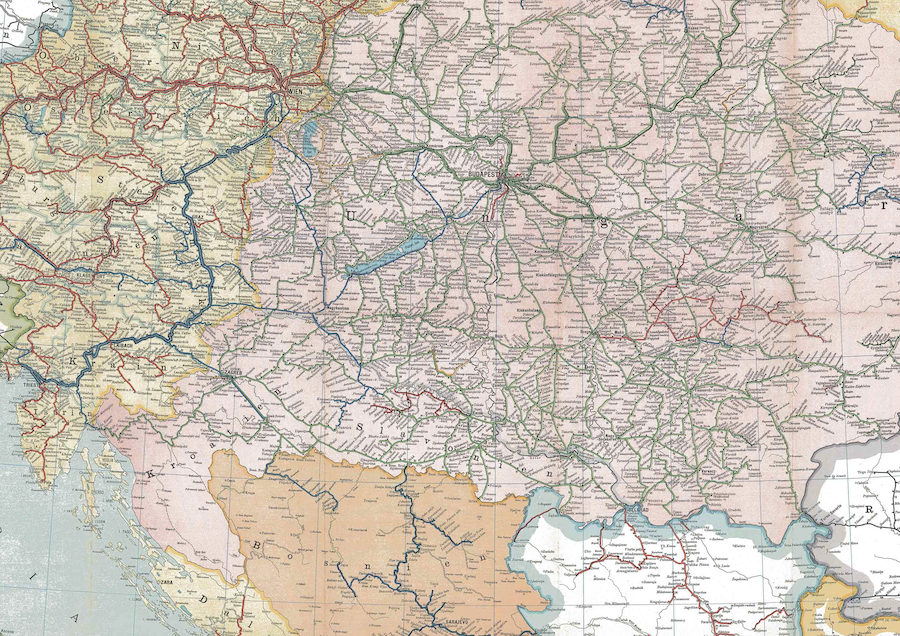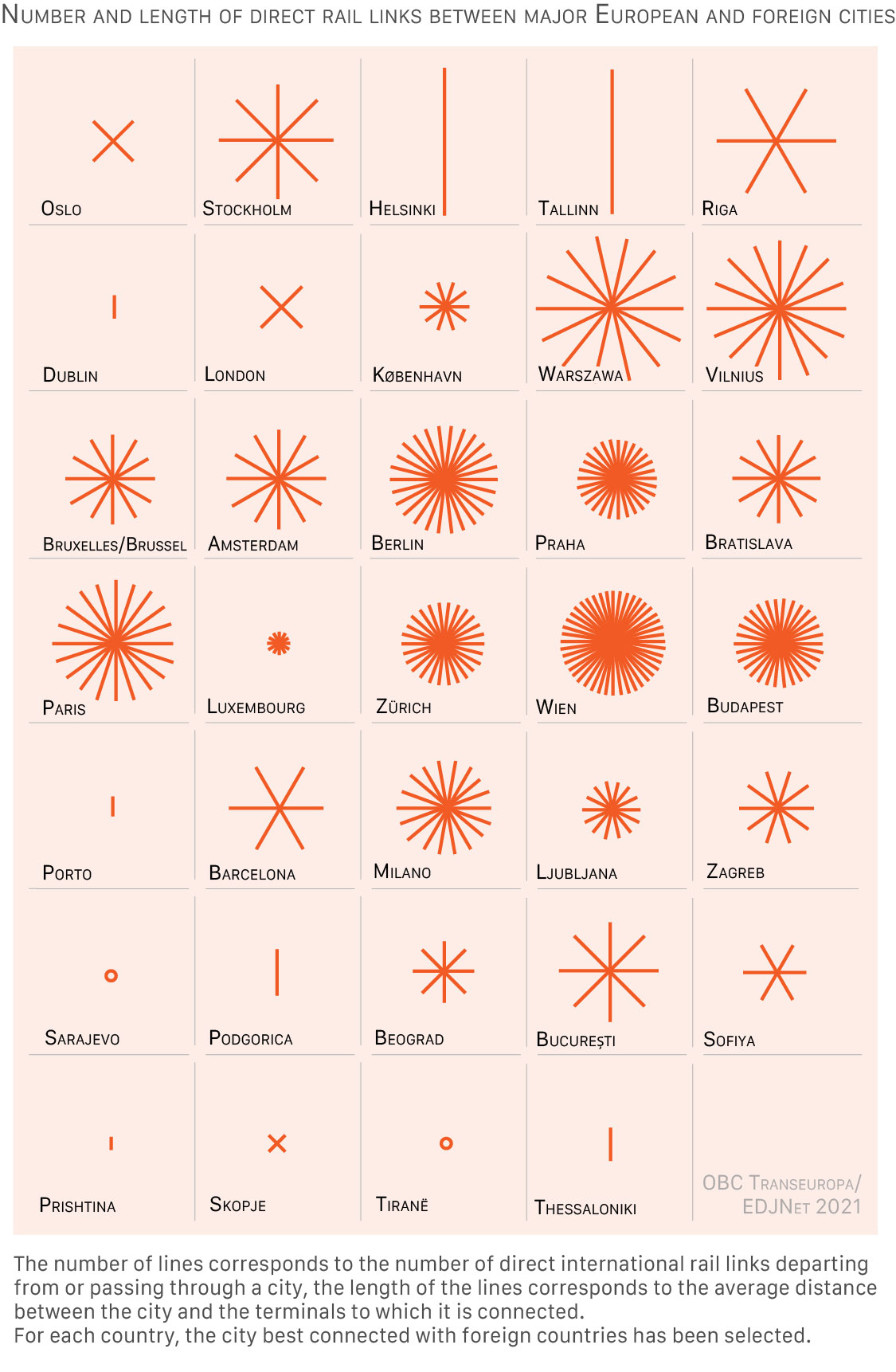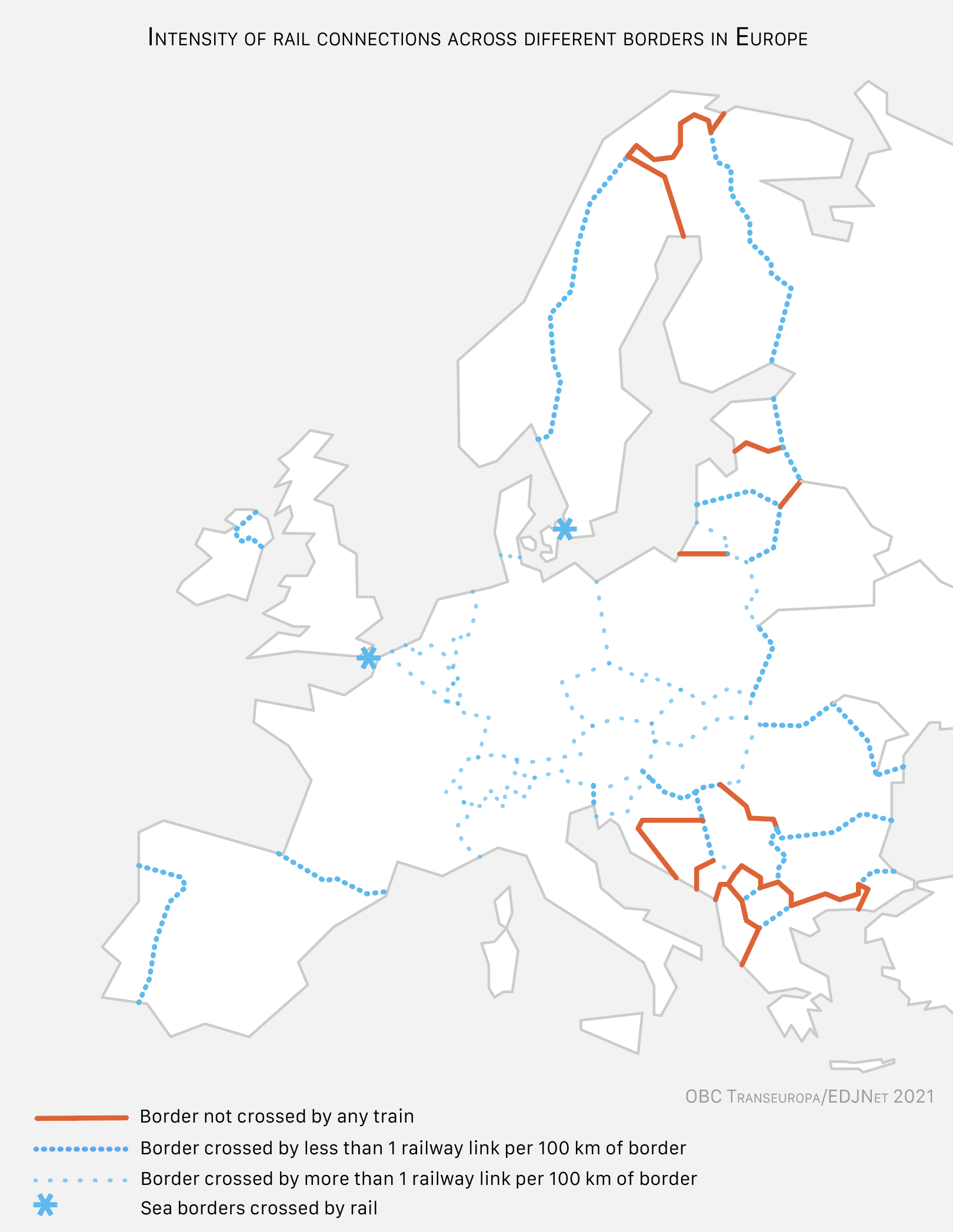More and more trains crossing European borders
A dense network of cross-border rail connections cuts through the continent, and it’s set to expand even further in the coming years thanks to new infrastructure and the birth of the European single rail market. However, there are still profound differences between the central and peripheral regions of Europe

More-and-more-trains-crossing-European-borders
Detail of the railway map of the Austro-Hungarian empire in 1911 (Wikimedia Commons )
Imagine you’re in Vienna and can go on vacation without having to worry about Covid-19. Boarding a train in the Austrian capital, you can choose from 23 different lines to take you straight to destinations such as Amsterdam, Rome, Split, Bucharest, Gdansk, even Moscow, without a single transfer.
Vienna is the European city with the most international rail connections, and Austria, along with Germany, is the European country best connected by rail with other European countries.
These are far from the only passenger trains crossing borders in Europe: each European country can count on an average of 20 direct train connections with foreign countries, and all of them have at least one, with the sole exception of Albania, while Greece’s foreign connections are only open during the summer period. The European Commission estimates that cross-border transit accounts for as much as seven percent of total passenger train traffic in Europe, and this percentage will rise further in the coming years if planned innovations and investments yield the desired results.
As part of efforts to reduce greenhouse gas emissions, the European Union and Member States are aiming to increase the promotion of rail transport for both freight and passengers. Although rail transit has grown in popularity in recent years, people currently use rail for only eight percent of their land travel.
In June 2020, 27 European countries signed a declaration calling for a "European agenda on international rail passenger transport." With this document in mind (among other things), 2021 has been declared the European Year of Railways, which officially launches today . A series of related initiatives by the European Commission are also expected in the coming months.
The existing cross-border rail connections
When we talk about international trains, we generally think of high-speed trains connecting major capitals, like Eurostar or Thalys, or night trains. In reality, cross-border rail connections in Europe mostly consist of daytime trains and ordinary speeds: among the 271 connections we surveyed, high speed and night trains respectively cover just 7 percent and 16 percent of the total, while 40 percent of routes is served by ordinary daytime trains and 37 percent by local cross-border traffic. When it comes to stitching together the territories divided by borders, the role played by local lines is perhaps the one most often ignored.
Looking at the density of the European international rail network, Central Europe stands out. Vienna, Budapest, Prague and Berlin are the capitals with the best connections to foreign countries, and each of their respective countries can count on more than forty different connections to foreign countries.
This is not surprising: after all, these are countries with very long land borders, surrounded by many different states and located at the heart of Europe. Even neighboring countries like Denmark, Slovakia, and Slovenia have a particularly high number of international connections relative to their size.
There is also a historical reason: many railroads in the region were built over a century ago by the German and Austro-Hungarian empires. When the empires fell, the railroads remained while the national borders multiplied and shifted. Even today, the borders between Austria and Slovakia, Czech Republic and Silesia, Hungary and Transylvania, are among those crossed by the highest number of trains.
On the other hand, the peripheral regions of Europe – such as the Iberian Peninsula, the Balkan Peninsula, or the Baltic area – can generally count on only a few international rail connections, and these are often slow and poorly served. For example, despite sharing more than a thousand kilometers of land border with neighboring countries, Greece and Finland can rely on only a single rail link with foreign countries. Portugal and Bulgaria are also poorly connected with neighboring countries. Lisbon, Madrid, Sarajevo, Tirana and Athens are the only European capitals without a direct rail connection to foreign countries.
Future cross-border rail connections
There are countries such as Croatia and Romania where a large proportion of foreign-bound trains point westward, virtually ignoring the neighboring states. The existence of numerous rail links between a given pair of countries can be taken as an indicator of intense bilateral relations: they imply close historical relationships and significant flows of people.
However, such relationships also work in the opposite direction: strengthening cross-border rail networks helps bind territories and populations more closely together. This is another reason for the European Union’s political (and economic) investment in this area.
In order to improve cross-border rail connections, the European Commission takes aim, first and foremost, at the infrastructure: doubling tracks and electrifying existing lines, constructing new tunnels, investing in high speed trains, harmonizing safety mechanisms, and more. The main points of the Trans-European Transport Network (TEN-T) should be completed by 2030: Europe will have faster Alpine crossings, more high-speed cross-border lines, and a modernised network in Central and South-Eastern Europe. However, improvements on cross-border sections are among the most delicate aspects of the roadmap, and progress is so slow that the European Commission is expected to support them with targeted interventions in the coming months.
Ultimately, good tracks are not enough: in order to really strengthen the popularity of cross-border rail connections, it is also necessary to simplify the rules and procedures governing rail traffic, which until recently have been highly fragmented and burdensome for operators. As of 31 October 2020, the EU Railway Agency (ERA) is the single certification body for vehicles and rail traffic operators within the EU.
The EU’s Fourth Railway Package, a set of measures approved in 2016 and currently being implemented, establishes a single market for rail services in Europe and makes it much easier for operators to serve routes in countries other than their own. It should also soon become much easier for citizens to research and book tickets involving multiple operators . According to the European Commission’s calculations, increased competition will increase supply and lower prices.
Finally, the European Union could intervene to subsidize connections that are important, but for which there is insufficient market demand, such as the Lisbon-Madrid route.
With the birth of the single rail market, several countries and operators have already announced the expansion of their cross-border connections. Germany, for example, has recently presented Trans Europe Express 2.0 , which should improve connections such as those between Amsterdam and Rome, or Berlin and Barcelona. Other projects focus on night trains, with Austria, Switzerland, Germany and France jointly announcing an expansion of their timetables in the coming years.
You can find more details on the methodology at the bottom of this page . The article was updated on 30 March.
This article is published in collaboration with the European Data Journalism Network and it is released under a CC BY-SA 4.0 license.
Tag: EDJNet
Featured articles
- Take part in the survey
More and more trains crossing European borders
A dense network of cross-border rail connections cuts through the continent, and it’s set to expand even further in the coming years thanks to new infrastructure and the birth of the European single rail market. However, there are still profound differences between the central and peripheral regions of Europe

More-and-more-trains-crossing-European-borders
Detail of the railway map of the Austro-Hungarian empire in 1911 (Wikimedia Commons )
Imagine you’re in Vienna and can go on vacation without having to worry about Covid-19. Boarding a train in the Austrian capital, you can choose from 23 different lines to take you straight to destinations such as Amsterdam, Rome, Split, Bucharest, Gdansk, even Moscow, without a single transfer.
Vienna is the European city with the most international rail connections, and Austria, along with Germany, is the European country best connected by rail with other European countries.
These are far from the only passenger trains crossing borders in Europe: each European country can count on an average of 20 direct train connections with foreign countries, and all of them have at least one, with the sole exception of Albania, while Greece’s foreign connections are only open during the summer period. The European Commission estimates that cross-border transit accounts for as much as seven percent of total passenger train traffic in Europe, and this percentage will rise further in the coming years if planned innovations and investments yield the desired results.
As part of efforts to reduce greenhouse gas emissions, the European Union and Member States are aiming to increase the promotion of rail transport for both freight and passengers. Although rail transit has grown in popularity in recent years, people currently use rail for only eight percent of their land travel.
In June 2020, 27 European countries signed a declaration calling for a "European agenda on international rail passenger transport." With this document in mind (among other things), 2021 has been declared the European Year of Railways, which officially launches today . A series of related initiatives by the European Commission are also expected in the coming months.
The existing cross-border rail connections
When we talk about international trains, we generally think of high-speed trains connecting major capitals, like Eurostar or Thalys, or night trains. In reality, cross-border rail connections in Europe mostly consist of daytime trains and ordinary speeds: among the 271 connections we surveyed, high speed and night trains respectively cover just 7 percent and 16 percent of the total, while 40 percent of routes is served by ordinary daytime trains and 37 percent by local cross-border traffic. When it comes to stitching together the territories divided by borders, the role played by local lines is perhaps the one most often ignored.
Looking at the density of the European international rail network, Central Europe stands out. Vienna, Budapest, Prague and Berlin are the capitals with the best connections to foreign countries, and each of their respective countries can count on more than forty different connections to foreign countries.
This is not surprising: after all, these are countries with very long land borders, surrounded by many different states and located at the heart of Europe. Even neighboring countries like Denmark, Slovakia, and Slovenia have a particularly high number of international connections relative to their size.
There is also a historical reason: many railroads in the region were built over a century ago by the German and Austro-Hungarian empires. When the empires fell, the railroads remained while the national borders multiplied and shifted. Even today, the borders between Austria and Slovakia, Czech Republic and Silesia, Hungary and Transylvania, are among those crossed by the highest number of trains.
On the other hand, the peripheral regions of Europe – such as the Iberian Peninsula, the Balkan Peninsula, or the Baltic area – can generally count on only a few international rail connections, and these are often slow and poorly served. For example, despite sharing more than a thousand kilometers of land border with neighboring countries, Greece and Finland can rely on only a single rail link with foreign countries. Portugal and Bulgaria are also poorly connected with neighboring countries. Lisbon, Madrid, Sarajevo, Tirana and Athens are the only European capitals without a direct rail connection to foreign countries.
Future cross-border rail connections
There are countries such as Croatia and Romania where a large proportion of foreign-bound trains point westward, virtually ignoring the neighboring states. The existence of numerous rail links between a given pair of countries can be taken as an indicator of intense bilateral relations: they imply close historical relationships and significant flows of people.
However, such relationships also work in the opposite direction: strengthening cross-border rail networks helps bind territories and populations more closely together. This is another reason for the European Union’s political (and economic) investment in this area.
In order to improve cross-border rail connections, the European Commission takes aim, first and foremost, at the infrastructure: doubling tracks and electrifying existing lines, constructing new tunnels, investing in high speed trains, harmonizing safety mechanisms, and more. The main points of the Trans-European Transport Network (TEN-T) should be completed by 2030: Europe will have faster Alpine crossings, more high-speed cross-border lines, and a modernised network in Central and South-Eastern Europe. However, improvements on cross-border sections are among the most delicate aspects of the roadmap, and progress is so slow that the European Commission is expected to support them with targeted interventions in the coming months.
Ultimately, good tracks are not enough: in order to really strengthen the popularity of cross-border rail connections, it is also necessary to simplify the rules and procedures governing rail traffic, which until recently have been highly fragmented and burdensome for operators. As of 31 October 2020, the EU Railway Agency (ERA) is the single certification body for vehicles and rail traffic operators within the EU.
The EU’s Fourth Railway Package, a set of measures approved in 2016 and currently being implemented, establishes a single market for rail services in Europe and makes it much easier for operators to serve routes in countries other than their own. It should also soon become much easier for citizens to research and book tickets involving multiple operators . According to the European Commission’s calculations, increased competition will increase supply and lower prices.
Finally, the European Union could intervene to subsidize connections that are important, but for which there is insufficient market demand, such as the Lisbon-Madrid route.
With the birth of the single rail market, several countries and operators have already announced the expansion of their cross-border connections. Germany, for example, has recently presented Trans Europe Express 2.0 , which should improve connections such as those between Amsterdam and Rome, or Berlin and Barcelona. Other projects focus on night trains, with Austria, Switzerland, Germany and France jointly announcing an expansion of their timetables in the coming years.
You can find more details on the methodology at the bottom of this page . The article was updated on 30 March.
This article is published in collaboration with the European Data Journalism Network and it is released under a CC BY-SA 4.0 license.
Tag: EDJNet













